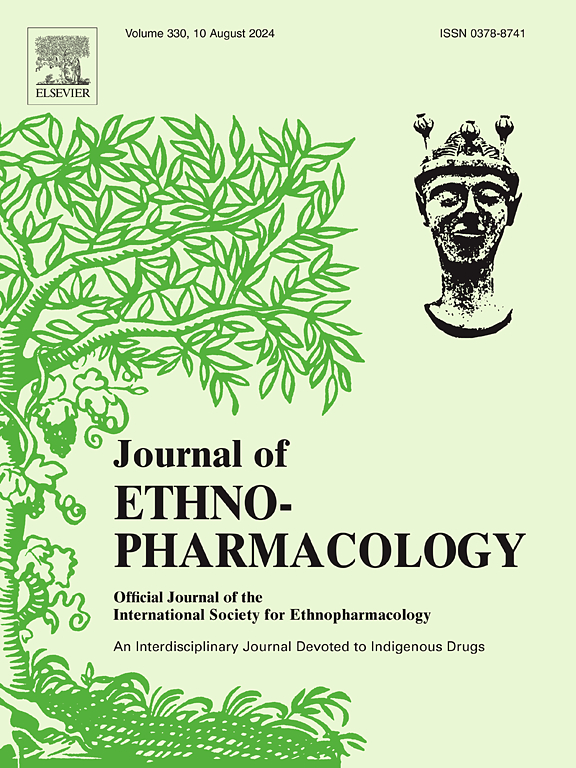Uncaria rhynchophylla alkaloid extract exerts neuroprotective activity against Parkinson's disease via activating mitophagy with the involvement of UCHL1
IF 5.4
2区 医学
Q1 CHEMISTRY, MEDICINAL
引用次数: 0
Abstract
Ethnopharmacological relevance
Uncaria rhynchophylla (Miq.) Miq. ex Havil. (UR), a traditional Chinese medicinal plant, plays an active role in neuroprotection. Clinical medication and modern pharmacological studies have proved the efficacy of UR against Parkinson's disease (PD), with alkaloids being recognized as the main bioactive components. But the therapeutic effect and mechanism of U. rhynchophylla alkaloid extract (URA) against PD need further exploration.
Aim of study
The study aimed to investigate the therapeutic effect and potential mechanism of URA on PD.
Materials and methods
LC-MS methodology was used to evaluate the chemical constituents of URA. The anti-PD activity of URA in vivo was measured on the mouse and rat models of PD. Neuroprotective effect of URA on PC12 cells was measured by MTT assay. Dopamine (DA) and its metabolites were detected by LC-MS for probing the protection ability on dopaminergic neurons. The differentially expressed proteins between model group and URA administrated group were analyzed by proteomics, suggesting oxidative phosphorylation as possible pathway of URA. Considering the critical role of mitochondria in oxidative phosphorylation, JC-1 staining, MitoSOX staining, transmission electron microscopy (TEM) observation and adenosine triphosphate (ATP) levels detection were used to analyze the effects of URA on mitochondrial morphology and function. Biolayer interferometry (BLI) was used to search for the possible UCHL1-bonding compounds in URA.
Results
URA significantly mitigated the behavioural defects by improving coordination, shortening the time to climb down the whole pole (T-LA) and increasing the forelimbs’ muscle strength of MPTP-induced PD mice and 6-OHDA-induced PD rats. In addition, URA improved tyrosine hydroxylase expression in dopaminergic neurons by immunohistochemistry (IHC) staining, and thus increased the neurotransmitter levels of DA and relevant metabolites. Furthermore, URA promoted mitophagy as reflected by a significant decrease in reactive oxygen species (ROS) generation, an increase in ATP levels and clearance of damaged mitochondria. Subsequently, Ubiquitin C-terminal hydrolase 1 (UCHL1), which is associated with the mitochondrial dysfunction in PD, is suggested to be a promising target based on the proteomics result, and proved by the blocked protective effects of URA by UCHL1 inhibitor. Furthermore, hirsuteine (HTE) was identified as a potential active compound of URA binding to UCHL1 by BLI, and the binding capacity and site were verified by surface plasmon resonance (SPR) and molecular docking.
Conclusion
This work demonstrates that URA exerts effective neuroprotective activity against PD via activation of mitophagy with the involvement of UCHL1, and HTE may be a potential active compound of URA.

黄连生物碱提取物在 UCHL1 的参与下通过激活有丝分裂对帕金森病具有神经保护活性。
民族药理学意义:Uncaria rhynchophylla (Miq.) Miq.(UR)是一种传统的中药植物,在神经保护方面发挥着积极作用。临床医学和现代药理学研究证明,茵陈对帕金森病(PD)有一定疗效,其中生物碱是公认的主要生物活性成分。但荨麻疹生物碱提取物(URA)对帕金森病的治疗效果和机制还需要进一步探索:本研究旨在探讨URA对帕金森病的治疗效果和潜在机制:采用LC-MS方法评估URA的化学成分。在小鼠和大鼠模型中测定了URA的体内抗PD活性。MTT试验测定了URA对PC12细胞的神经保护作用。用LC-MS检测多巴胺(DA)及其代谢,以探究URA对多巴胺能神经元的保护能力。蛋白质组学分析了模型组和 URA 施用组的差异表达蛋白,表明氧化磷酸化是 URA 的可能作用途径。考虑到线粒体在氧化磷酸化中的关键作用,研究人员采用JC-1染色、MitoSOX染色检测、透射电子显微镜(TEM)观察和三磷酸腺苷(ATP)水平检测来分析URA对线粒体形态和功能的影响。生物层干涉测量法(BLI)用于寻找URA中可能的UCHL1键合化合物:结果:URA能明显改善MPTP诱导的帕金森病小鼠和6-OHDA诱导的帕金森病大鼠的行为缺陷,包括改善协调性、缩短爬下整杆(T-LA)的时间和增加前肢肌力。此外,URA通过IHC染色改善了多巴胺能神经元中酪氨酸羟化酶的表达,从而提高了DA及相关代谢产物的神经递质水平。此外,URA 还能促进线粒体吞噬,具体表现为活性氧(ROS)生成显著减少、ATP 水平上升以及受损线粒体的清除。随后,与帕金森病线粒体功能障碍有关的泛素 C 端水解酶 1(UCHL1)被认为是一个有前景的靶点,这是基于蛋白质组学的结果,并通过 UCHL1 抑制剂阻断 URA 的保护作用得到了证明。此外,通过BLI鉴定了赫苏汀(HTE)作为URA与UCHL1结合的潜在活性化合物,并通过表面等离子体共振(SPR)和分子对接验证了其结合强度和位点:结论:本研究表明,URA在UCHL1的参与下通过激活有丝分裂对帕金森病具有有效的神经保护活性,而HTE可能是URA的潜在活性化合物。
本文章由计算机程序翻译,如有差异,请以英文原文为准。
求助全文
约1分钟内获得全文
求助全文
来源期刊

Journal of ethnopharmacology
医学-全科医学与补充医学
CiteScore
10.30
自引率
5.60%
发文量
967
审稿时长
77 days
期刊介绍:
The Journal of Ethnopharmacology is dedicated to the exchange of information and understandings about people''s use of plants, fungi, animals, microorganisms and minerals and their biological and pharmacological effects based on the principles established through international conventions. Early people confronted with illness and disease, discovered a wealth of useful therapeutic agents in the plant and animal kingdoms. The empirical knowledge of these medicinal substances and their toxic potential was passed on by oral tradition and sometimes recorded in herbals and other texts on materia medica. Many valuable drugs of today (e.g., atropine, ephedrine, tubocurarine, digoxin, reserpine) came into use through the study of indigenous remedies. Chemists continue to use plant-derived drugs (e.g., morphine, taxol, physostigmine, quinidine, emetine) as prototypes in their attempts to develop more effective and less toxic medicinals.
 求助内容:
求助内容: 应助结果提醒方式:
应助结果提醒方式:


